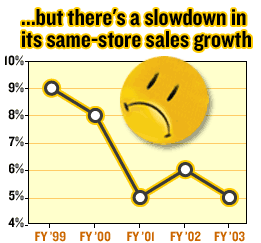NEW YORK (CNN/Money) -
Wal-Mart Stores has grown so big so fast. But now it can't grow fast because it's so big.
The world's largest retailer, at $245 billion in annual revenue, has seen sales growth slow over the past year. Its stock price, which skyrocketed in the 1990s, has stalled; it was 2003's sixth worst performer among the Dow Jones industrials.
"Wal-Mart has reached an inflection point. With a company of this size, it's tough to calculate where it's headed from here," said Mark Mandel, Blaylock & Partner analyst.
In its fiscal year ended January 2003, Wal-Mart's same-store sales averaged 5 percent growth. In the year ending this month, that's down to the 3 percent to 4 percent range.
Meanwhile, its closest discount competitor, Target (TGT: Research, Estimates), outperformed Wal-Mart's sales growth in five of the past six months.
For Wall Street, the implication is the stock will make money, but won't make you rich, according to Ulysses Yannas, analyst with Buckman, Buckman & Reid.
"Wal-Mart isn't a home run," said Yannas.
Size matters
Wal-Mart is huge. In the U.S., it boasts 1,476 discount stores, 1,430 supercenters, 533 Sam's Club warehouse stores and 60 neighborhood markets.
The bulk is slowing growth.

"The bigger it gets, the smaller the percentage growth will be," said Kurt Barnard, president of Barnard's Retail Consulting Group. "Let's say that when you add 10 new stores to 100 stores, you grow the business 10 percent. When you add 10 stores to 3,000 stores, the growth isn't obvious."
Others say the sales slowdown is not company-specific. The soft jobs market has transformed shopping behavior. While more consumers shop at discounters, they're still comparing prices at Wal-Mart, buying the cheaper alternative and fewer items.
Pricing pressures
Wal-Mart's mantra of "everyday low prices" may be written in stone. That's how it pounded its rivals -- setting prices not just below the competition but close to rock bottom while still making a profit.
But some in the industry say Wal-Mart might rethink the strategy.

"We believe poor recent results and management changes are leading to internal rethinking of [Wal-Mart's] aggressive deflationary pricing strategies, which we believe will lead to better gross margins in 2004, while still reducing prices," UBS analyst Gary Balter wrote in a research note.
"Wal-Mart's pricing does limit its topline and bottomline growth," said Thomson Financial's Perkins.
Others dismiss the notion of price adjustments.
"Absolutely not. Their low price strategy is central to who they are and how run their business," said Heather Brilliant, stock analyst with Morningstar.
Wal-Mart declined comment, saying it doesn't respond to speculation.
Cruising for opportunity
Wal-Mart's footprint already dominates most retail channels -- food, toys, apparel, consumer electronics and sporting goods.
With a cash base of $3 billion, Wall Street wants to know where the company is investing next.
"The market for Wal-Mart's supercenters will become saturated in four years," said Howard Davidowitz, chairman of retail consulting firm Davidowitz & Associates Inc.
Those bearish on Wal-Mart believe domestic new-store growth could be snagged as it expands into urban areas with higher real estate and wage costs.
So what's next? Brilliant thinks Wal-Mart will focus on international expansion and dominating apparel retailing.
"International expansion has strong growth potential," said Brilliant, expecting this area to contribute one-third of Wal-Mart's growth over the next five years. In 2003, Wal-Mart operated 1,400 stores in nine countries.
Added Brilliant, "The company is already an industry leader in apparel with 12 percent market share. But it generally aims for 30 percent share in any category it focuses on."
Best retailer, bad employer?
Labor is a thorny issue. It's alleged in lawsuits that Wal-Mart underpaid workers and used cleaning contractors it knew hired illegal immigrants.
A sex-discrimination lawsuit seeking to represent 1.6 million current and former female workers alleges Wal-Mart underpaid those workers compared to male counterparts and often overlooked them for promotions.
As the No. 1 private employer, Wal-Mart is an easy lawsuit target. But negative publicity is a business risk that can hurt the stock.
The United Food and Commercial Workers' bid to unionize Wal-Mart also has industry attention. Brilliant says Wal-Mart could suffer because it depends on low labor costs to boost profitability.
Taking stock
Wal-Mart (WMT: Research, Estimates)'s 2003 stock performance wasn't all that bad compared to recent years. Its worst yearly performance after its 1997 Dow initiation was 2000's 23.1 percent drop.
Since then, the stock, which trades at a premium to other discounters, has been stuck in a trading range, unable to surpass its all-time high of $69. It currently trades at a price-to-earnings multiple of 23 times next year's earnings compared to a P/E of 19.8 for the broadline retail group.

"The stock isn't going to double from here. The 36 cents a share annual dividend isn't why investors will hold on the stock," said Buckman, Buckman & Reid's Yannas. "We think the stock still has a decent upside to it as long as the company can grow earnings better than 10 percent a year and keep the multiple under 25."
Yannas rates the stock "outperform." He doesn't have a price target.
While investors may not be jittery -- short-interest activity on the Wal-Mart last month was just 2 percent, its lowest level for 2003 -- some money managers are less optimistic.
"We're betting against it for now in favor of other names that have more upside," said Tatiana Pohotsky of Independence Investors in Boston, which has a small Wal-Mart position in the fund she manages.
"We're concerned about pricing issues, Wal-Mart's cost structure and what it needs to do to shore up its margins. We think this company will grow very slowly over the next 10 years."

--analysts quoted in this story do not personally own shares of Wal-Mart and their firms do not have an investment banking relationship with the company.
|

